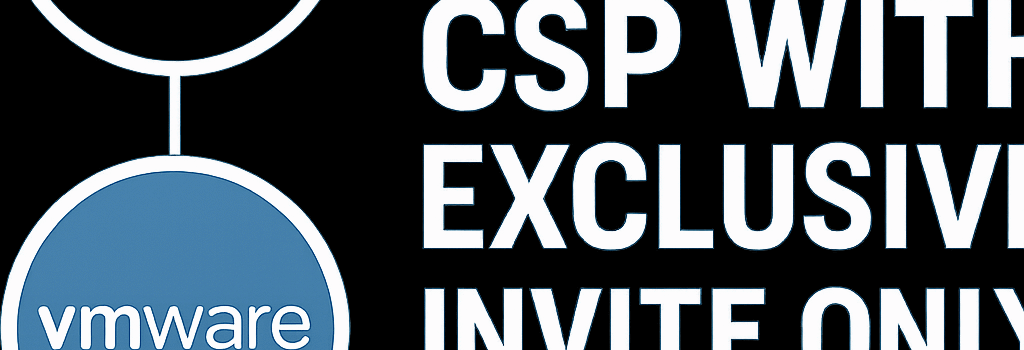Broadcom Limits VMware CSP with Exclusive Invite-Only Program

Broadcom has informed hundreds of VMware Cloud Service Providers (VCSPs) that they will be excluded from its revamped, invite-only channel partner program launching November 1. The move further consolidates Broadcom’s hold over the VMware ecosystem and raises questions about service continuity, licensing costs, and migration strategies for small and mid-sized providers and their customers.
1. New Invite-Only CSP Program Details
Effective November 1, the Broadcom Advantage Cloud Service Provider Program will only admit partners who meet stringent criteria:
- Minimum capacity of 3,500 physical processor cores under management across VMware clusters
- 24×7 global support operations with certified VMware administrators (VCP-DCV, VCAP-DCV)
- Annual cloud revenue threshold of USD 10 million or equivalent
- Regionally distributed data centers in at least two geographic zones
- Demonstrated integration with VMware Cloud Foundation (VCF) 9.0, NSX-T 4.x, and vSAN 8.0+
Broadcom’s stated goal is to drive “simplification, consistency, and innovation across the Go-To-Market ecosystem.” However, many smaller VCSPs—historically numbering over 4,000 globally—will not qualify, leaving them without renewal offers.
2. Impact on Small and Mid-Size CSPs
VCSPs excluded from the new program will receive non-renewal notices by mid-July and can continue to serve existing clients until October 31. After this cutoff, they and their end customers face:
- License renewal disruptions—clients must find new authorized partners or negotiate directly with VMware
- Service interruptions due to account migrations, new support SLAs, and possible data transfer delays
- Increased costs from migration, re-onboarding fees, and lost bundling discounts
According to Australia’s Interactive Technology, affected businesses could see licensing costs spike by up to 20% due to reduced partner competition and the need to repurchase support bundles.
3. End of the White-Label Cloud Program
Broadcom’s white-label initiative, introduced in mid-2024 to let smaller CSPs piggyback on larger partners’ VMware accreditation, will also shutter on October 31. This program had enabled hundreds of regional and niche providers to maintain VMware-based offerings without direct partnership.
3.1 Case Study: Multi-Region Virtualization Challenge
“I now have six months to design, procure, and build a new multi-region virtualization platform supporting millions in revenue, plus a year to migrate all our VMware clients,” wrote one affected CIO on Reddit. Their organization spends £300,000 (~USD 402,500) annually on VMware licensing alone.
4. Technical Deep Dive: VMware Cloud Foundation 9.0 and Ecosystem Simplification
Launched June 2025, VCF 9.0 integrates vSphere 8.0u3, NSX-T 4.1, and vSAN 8.0, enabling:
- Autonomous operations via AI-driven lifecycle management (vLCM with external software depot)
- Enhanced workload mobility with cross-region stretched clusters and vMotion improvements
- Integrated Kubernetes through Tanzu Kubernetes Grid (TKG) with upstream conformant runtime
VCF 9.0 demands certified hardware nodes (e.g., Dell VxRail, HPE Cloudline), further limiting partner eligibility to those with OEM agreements and scale-out inventory.
5. Risk Analysis and Migration Strategies
Displaced CSPs and end customers should adopt a structured migration approach:
- Inventory & Assessment: Audit current VMware deployments, custom integrations, and third-party plugins (backup, monitoring agents).
- Partner Evaluation: Shortlist authorized VCSPs based on SLA, geographic footprint, and pricing models.
- Proof-of-Concept: Validate compatibility of VCF 9.0 stacks or alternative hyperconverged solutions (Nutanix AHV, Red Hat OpenShift).
- Automated Migration: Use VMware HCX for live workload migration or HashiCorp Terraform for IaC-driven re-provisioning.
- Cutover & Validation: Establish rollback plans, performance benchmarks, and end-user acceptance tests.
6. Alternatives for Displaced CSPs and End Customers
- AWS: AWS Outposts or VMware Cloud on AWS managed service
- Azure: Azure VMware Solution integrated with Azure Arc
- Google Cloud: VMware Engine with regionally distributed support
- Open Source Stacks: KVM-based OpenStack distributions (Red Hat, Mirantis), Proxmox VE clusters
7. Expert Opinions and Market Outlook
Gartner VP Analyst Michael Warrilow warns: “Broadcom’s partner cull risks undermining one of tech’s most vibrant ecosystems, driving customers into hyperscaler lock-in.”
Sumit Bhatia, co-author of Navigating VMware Turmoil, predicts a 15–25% increase in cloud service pricing over the next 12 months as partner consolidation reduces competitive pressure.
Regulatory scrutiny is mounting: the EU Commission is reviewing Broadcom’s post-acquisition market behavior for potential antitrust concerns, given VMware’s 30% share of the enterprise virtualization market.
8. Conclusion
Broadcom’s invite-only VCSP program and the simultaneous end of the white-label scheme signal a decisive shift toward a leaner partner ecosystem focused on hyperscale private clouds. Small and mid-sized providers must act quickly to validate technical roadmaps, secure new partnerships, and mitigate migration risks. For clients, understanding the full TCO of switching providers or platforms will be critical to maintaining service continuity and budget predictability.